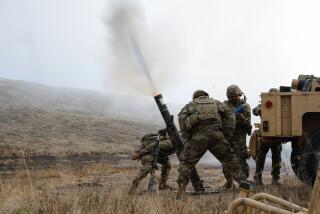A Final Salute for Naval Station : Ceremonies: Officers, sailors and veterans share memories and bid farewell as Long Beach base closes.
Even as the flags were marched away and the final ship’s bell rang Friday, marking the end of the Long Beach Naval Station, it was clear that few were willing to surrender.
*
After all, this base was once the epitome of the Navy on the West Coast. The observation tower, the forest of spiked gray masts and swarm of white uniforms were symbols of strength in hard times.
“Maybe next year, someone will decide we really need Naval Station Long Beach,” said the base commander, Capt. Isaiah J. Jones. “But it will always be here in one way or another.”
After the Navy hospital was closed this year, along with two large housing complexes for Navy personnel on the city’s west side, that seems unlikely. Already, cities and agencies are haggling over development plans for the abandoned properties.
But even if the station remains only in memory, the sailors who passed through it helped shape Southern California. The base was the gateway to California for tens of thousands of young men arriving during World War II and the Korean War.
Fine weather and a glut of jobs in the region’s growing defense industry convinced many to move their families here, eventually helping create the great Southern California boom.
“Long Beach told them life was better here than in snowy Buffalo or humid Atlanta,” said Donald Waldie, public information officer for the city of Lakewood. Waldie, who is writing a book that details the area’s growth, can trace his own history to the Long Beach base. His father fell in love with Southern California after landing here in 1942 as a lieutenant commander serving on the Bradford. He left Manhattan for good.
“These young men helped fuel the boom,” Waldie said. “By 1950, just in time for the Korean conflict, they were beginning construction on 50 houses a day (in Lakewood). In 33 months, 17,500 homes were built here.
*
Long Beach was not the Navy’s only port. Bases in San Diego and Santa Barbara created parallel growth. Long Beach is the region’s first base to close--the victim of post-Cold War downsizing, a lingering recession and political pressures to reduce military spending.
The 15,000 officers and enlisted personnel who used to serve the 38-ship fleet in Long Beach have nearly vanished. They have retired, been reassigned or are waiting out the next round of base closures at the Navy shipyard next door to the naval station.
Of the 2,500 active-duty personnel left on base after Friday, nearly half belong to the Tarawa. But the amphibious assault ship is due to return to San Diego by the end of the year.
The shipyard was narrowly saved from closure last summer when the commission voted 4 to 3 to keep it open. The commission is expected to reconsider the shipyard next year.
“This is a crying shame,” said retired Chief Boatswain Mate Lawrence F. FitzGerald, who served in Korea and World War II. “I experienced what we went through when they shrunk the service after the Second World War. I saw ships torn apart. And then all they had was a bucket of rocks and a big stick (at the beginning of the Korean War).”
Like so many others at Friday’s closing ceremony, FitzGerald’s memories of the base were entwined with recollections of overseas battles. Asked how they felt about the station’s demise, retirees told stories about troops sent ashore disguised as softball players, pre-dawn launches and the silence of waiting in a submarine.
Before and after overseas tours and wars, they knew Long Beach was waiting. Jones remembered his first date with his wife--July 4, 1963, at the Pike amusement park, which is closed. Others remembered a downtown swamped in sailors’ whites or the spot just outside base where civilians would stop to give a Navy man a ride into town. To most of them, Long Beach without a Navy was inconceivable.
That unwillingness to accept the base’s demise was evident in a program printed for the ceremony. It was titled “The Third Disestablishment”--a reminder that the Navy’s fortunes have swelled here as often as they have plummeted.
In 1919, Long Beach was the Pacific Fleet’s home port, even though the base was not officially established until 1942. The station was closed in April, 1950, then reopened 10 months later. It closed again in June, 1974, but was reopened in October, 1979.
The base may be closing for good this time, but most chose to believe that there would always be a Navy in Long Beach. In front of the Officers’ Club, a marquee held an almost defiant proclamation. It said: “O Club Will Remain Open.”
More to Read
Sign up for Essential California
The most important California stories and recommendations in your inbox every morning.
You may occasionally receive promotional content from the Los Angeles Times.









